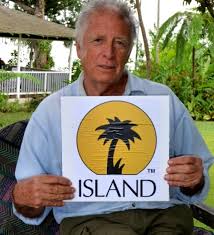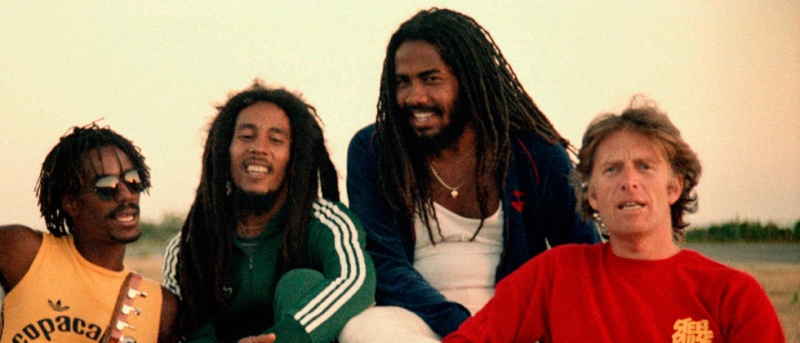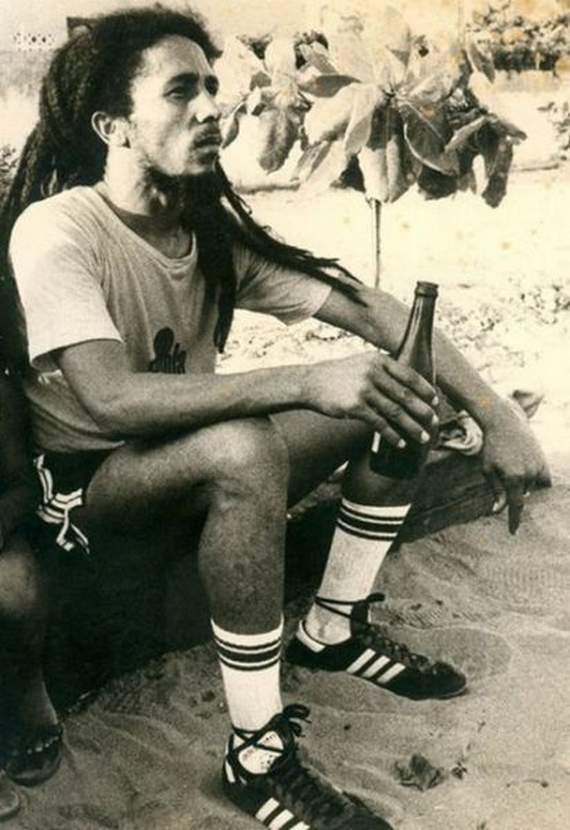
Bob Marley has been called “the first third world superstar”, a visionary, a revolutionary and even a prophet. Certainly he was one of the most characteristic and challenging performers of this century. His timeless and evocative music continues to have an enormous impact on people of all races throughout the world.
Like most popular artists, Marley wrote about love. But his music also reflected a militant spirituality, a blood-red hatred of racism and colonialism, and a deep yearning for personal, artistic, political and social freedom. It is important to consider the roots of this legend. All these themes reflected the experiences of a man of mixed racial heritage growing up in a poverty-stricken crown colony. Marley was the product of Jamaica, a country with a unique mixture of black pride and fundamentalist religions set against a background of extreme economic deprivation.
Although there was clearly genius in his vocal abilities, in his on-stage charisma and in his vastly underrated guitar work, it was Marley¹s attitude and lyrics that made a lasting impact on listeners. He mined fresh artistic territory by reflecting the concerns of impoverished people everywhere.
Marley¹s musical career stretched over twenty years. During that time his style reflected every new development in the rise of modern Jamaican music-from ska to contemporary “international” reggae.

His first recordings were made as the beginning of the 1960s as a solo artist. In1962 Marley auditioned for a local music entrepreneur named Leslie Kong. Impressed by the quality of Bob¹s vocals, Kong took the young singer into the studio. He cut three sides, the first of which, Judge Not, was his first release on Kong¹s Beverly label.
Neighborhood Corner Store: Keith and Yook Moy Kong - Kingston, Jamaica.

Bob was tutored during these early years by Joe Higgs, an established singer from the area who held informal lessons for aspiring vocalists in the tenement yards of Trench Town, Kingston. It was here that Marley and his friend Bunny Livingston met Peter Macintosh and decided to form the Wailing Wailers. (Macintosh later shortened his name to Tosh, while Livingston became known as Bunny Wailer.)

The new group had a mentor, a Rastafarian hand drummer named Alvin Patterson who introduced the youths to Clement “Coxsone” Dodd, an important record produced in Kingston. In the summer of 1963 Dodd auditioned the Wailing Wailers and agreed to record them. It was in early 1964, as a founding member of the Wailing Wailers that Bob first hit the Jamaican charts.

The record was Simmer Down, recorded in the last weeks of 1963 on Dodd¹s Downbeat label. By January of 1964 it was number one. Simmer Down caused a sensation in Jamaica and the Wailers began recording regularly for Dodd¹s Studio One company. This was the era of ska; a hot new music with a pronounced backbeat. Ska had its origins in the New Orleans rhythm & blues picked up from American radio stations and played at local “sound systems”.
Over the next few years the Wailers – a group that also included at various times Junior Braithwaite and the back-up singers Beverly Kelso and Cherry Smith – put out some 30 sides and established themselves as one of the hottest groups in Jamaica. Despite their popularity however, the economics of staying together proved too much and Braithwaite, Kelso, and Smith left the band. At roughly the same time Bob joined his mother in the United States. She had moved to Delaware and saved enough money to send him a ticket. Just before he moved he met young Rita Anderson, and on February 10, 1966, the two were married.
Marley¹s stay in the US was short-lived. He worked just enough to finance his real ambition: music. He returned in October to Jamaica to join up again with Peter and Bunny and re-form the group, now simply known as the Wailers.

It was during these years that Marley fully embraced Rastafari. One can not fully comprehend Marley or the Wailers¹ music without reference to this movement. There is a mystery at the heart of every religion; Rastafari¹s main object of worship is the former Emperor of Ethiopia Haile Selassie, who is seen as the personification of God on earth. Rastas acknowledge the origin of their religion in Christianity and Judaism while rejecting the “babylon hypocrisy” of the modern church. In addition to proclaiming the divinity of Selassie, worshippers yearn for a return to a homeland in Africa.
Jamaicans in general have managed to maintain many cultural connections to Africa. That African heritage was given serious political expression by Marcus Garvey, a Jamaican preacher and entrepreneur who founded the Universal Negro Improvement Association. This organisation advocated the creation of a new black state in Africa, free from white domination. Garvey also predicted the crowning of a new black king. A few years later, in 1930, Ras Tafari Makonnen became Emperor of Ethiopia and had taken a new name, Haile Selassie. The Emperor claimed to be the 225th ruler in a line that stretched back to Menelik, the son of Solomon and Sheba. Garvey¹s prediction inspired his followers to found the Rastafarian movement.

Marley¹s conversion was part of a religious revival that had touched many other Jamaican artists, many of whom had begun writing songs about exile and return to Africa. Such songs as Maytal¹s Six & Seven Books of Moses, Bob Andy¹s I¹ve Got to Go Back Home, and Desmond Dekker¹s Israelites mark the early influences of the Rasta movement on reggae music.
The Wailers¹ growing commitment to Rastafari brought them into conflict with Clement Dodd. Determined to control their own destiny, they formed their own record label, WailinŒ N¹ Soul ŒM. Despite a few early successes, the Wailers¹ limited experience forced the label out of business in late 1967. The group survived, however, initially as songwriters for a company associated with the American singer Johnny Nash. The following decade Nash had an international hit with Marley¹s Stir It Up.

The Wailers then joined forces with Lee “Scratch” Perry, the production genius who virtually re-invented the sound of Jamaican music. By the end of the Sixties, with Perry at the mixing desk, the Wailers were again back at the top in Jamaica. The combination of the Wailers and Perry resulted in some of the finest music the band ever made. Tracks like Soul Rebel, Duppy Conqueror, 400 Years, and Small Axe were classics that defined the future direction of reggae.
By the late sixties the Wailers music reflected Marley¹s new beliefs. Gone were the rude boy anthems; in their place was a growing commitment to spiritual and social issues the cornerstone of his real legacy. With its emphasis on “getting yours here on earth” Rastfarian unabashedly mixes spirituality with social criticism.
In 1970 Aston “Familyman” Barrett and his brother Carlton (bass and drums, respectively) joined the Wailers as musicians. The rhythm nucleus of Perry¹s studio band the Upsetters, they came to the Wailers unchallenged as Jamaica¹s hardest rhythm section. With the addition of the Barrett brothers the Wailers¹ reputation continued to grow throughout the Caribbean, though they remained essentially unknown internationally.

That same year Bob accepted an invitation from Johnny Nash to accompany him to Sweden, where the American singer had taken a film score commission. While in Europe Bob secures a recording contract with CBS, which was also Nash¹s company. By the autumn of 1971 the Wailers were in London, ostensibly promoting their CBS single Reggae on Broadway. Instead they found themselves stranded in Britain.
In December Marley walked into Basing Street studio of Island Records and asked to see its founder, Chris Blackwell. Blackwell had launched Island in Jamaica in the late 1950¹s. By 1962 he realised that, by re-locating to London, he could represent all his Jamaican rivals in Britain. The company was re-born in May, 1962, selling initially to the Jamaican population, centred mostly in London and Birmingham. Blackwell then produced a worldwide smash with My Boy Lollipop, a pop/ ska tune by the young Jamaican singer Millie Small.
Through the Sixties Island had grown to become the UK¹s prime source of Jamaican music, from ska through rock-steady and reggae. The company had also embraced white rock music, with such bands as Traffic, King crimson, Cat Stevens, Free and Fairport Convention. When Marley arrived at
Island, it was the hottest independent in the world.


Blackwell knew of Marley¹s Jamaican reputation. Island had released his first records in Britain. More importantly, Blackwell had also heard the group¹s recent demo tapes and had been impressed. He offered the group a deal unique for Jamaican music; the Wailers were advanced $8000 to make an album.
The relationship that developed between Island and the Wailers was unprecedented. For the first time a reggae band had access to the best recording facilities and were treated in the same way as a rock group. Before the Wailers signed to Island, reggae had been sold only as singles and on cheaply produced compilations. The Wailers¹ first album, Catch A Fire broke all the rules. Beautifully packaged and heavily promoted, its releases marked the start of Marley¹s long climb to international fame and recognition.

Years later the acclaimed reggae dub poet Linton Kwesi Johnson, commenting on Catch A Fire, wrote: ” A whole new style of Jamaican music has come into being. It has a different character, a different soundŠwhat I can only describe as International Reggae. It incorporates elements from popular music: rock and soul, blues and funk. These elements facilitated a breakthrough on the international market.”
Island also decided The Wailers should tour both Britain and America, again a complete novelty for a reggae band. Marley and the band came to London in April 1973, embarking on a club tour which sharpened them as a live group. After three months, however, the band returned to Jamaica and Bunny, disenchanted by life on the road, refused to do the American tour. His place was taken by Joe Higgs, the original teacher of the Wailers. The tour drew packed houses, including a weekend engagement playing support to a young Bruce Springsteen.

Such was the demand for a group that and autumn tour was arranged, with 17 dates as support to Sly & The Family Stone, at that time the top band in Black American music. Four shows into the tour, however, the Wailers were taken off the bill. It seems they had been too good; support bands should never detract from the main attraction. The Wailers made their way to San Francisco where they broadcast a live concert for the pioneering rock station, KSAN. The bulk of that session was finally made available in February 1991, when Island releases the commemorative album Talkin¹ Blues.
Catch A Fire was followed a year later by Burnin¹, an LP that included remakes of some of the band¹s older songs such as Duppy Conqueror, Small Axe and Put It On, together with such stand out tracks as Get Up, Stand Up and I Shot The Sheriff (the latter recorded by Eric Clapton, who had a number one hit with the song in America).

The following year Marley spent much of his time in the studio working on sessions that eventually provided Natty Dread, an album that included such fiercely committed songs as Talkin¹ Blues, No Woman No Cry, So Jah Seh, revolution, and Them Belly Full (But We Hungry). By the start of the next year, however, Bunny and Peter had left the group. They were late to embark on solo careers while the band was re-named Bob Marley & the Wailers.
Natty Dread was released in February 1975. By the summer, the band was on the road again. Bunny¹s and Peter¹s harmonies were replaced by the I-Threes, the female trio comprised of Rita with Marcia Griffiths and Judy Mowatt. Among the concerns were two shows at the Lyceum Ballroom in London which, even now, are remembered as highlights of the decade.
The shows were recorded and the subsequent Live! album, together with the single, No Woman No Cry, climbed into the UK charts. By November, when the Wailers returned to Jamaica to play a benefit concert with Stevie Wonder, they were without question the country¹s biggest stars.
Their next album, released in 1976, finally cracked the American charts. Rastaman Vibration was, for many, the clearest exposition yet of Marley¹s music and beliefs. It included such brilliant tracks as Crazy Baldhead, Johnny Was, Who the Cap Fit and, perhaps most significantly of all, War, the lyrics of which were taken from a speech by Haile Selassie.

Rastaman Vibration¹s international success cemented Marley¹s growing political importance in Jamaica, where his strong Rastafarian stance had resonated with the ghetto youth. By way of thanking the people, Marley decided to play at a free concert at Kingston¹s National Heroes Park in December of 1976. The idea was to emphasize the need for peace in the slums of the city, were warring factions had brought turmoil and murder.
Just after the concert was announced, the Government called an election for December 20th. The campaign was a signal for renewed ghetto fighting and, on the eve of the concert, gunmen broke into Marley¹s house and shot him. In the confusion the would-be assassins only wounded Marley, who was hastily taken to a safe haven in the hills surrounding Kingston. Rita Marley and Bob¹s then manager, Don Taylor, were also wounded.

For a day he deliberated about playing the concert and then, on December 5, came on stage and played a brief set in defiance of the gunmen. It was to be Marley¹s last appearance in Jamaica for nearly eighteen months. Immediately after the show he left the country and, during early 1977, lived in London where he recorded his next album.
In 1977 Exodus firmly established Marley¹s international superstar status.
It remained in the British charts for 56 straight weeks, and netted three UK hit singles, Exodus, Waiting in Vain, and Jamming. The band also played a week of concerts at London¹s Rainbow Theatre, their last dates in the city during the Seventies.
1978¹s Kaya saw the band capitalise on their new international success. It hit number four on the UK charts the week of its release. The album saw Marley in a different mood Kaya was an album of love songs, and of course, homages to the power of ganga.
There were several other events in 1978 which were of extraordinary significance to Marley. In April that year he returned to Jamaica to play the One Love Peace Concert in front of prime Minister Michael Manley, Opposition Leader Edward Seaga and a crowd of tens of thousands. And at the end of the year he visited Africa for the first time, initially going to Kenya and then on to Ethiopia, spiritual home of the Rastafarians. In the same year he received the United Nation¹s Medal of Peace.

That same year the band toured Europe and America, a series of shows that provided a second live album, Babylon By Bus. The Wailers also broke new ground by playing Australia, Japan and New Zealand.
In 1979 the Survival LP was released, Marley¹s ninth album for Island records. It included Zimbabwe, a stirring anthem for the soon-to-be liberated Rhodesia, together with So Much Trouble in the Night and the anthemic Africa Unite. As the sleeve design (comprising the flags of the independent nations) indicated, Survival was an album devoted to pan-African solidarity.
At the start of the following year – a new decade Marley & the Wailers flew to Gabon to make their debut on the African continent. It was not the event that Marley had anticipated however as it quickly became evident that the band would be performing only for that country¹s elite. Marley returned to Africa in 1980 at the official initiation of the Government of Zimbabwe to play at that country¹s independence Ceremony. It was perhaps the greatest honour ever afforded the band, and one which underlined the Wailers¹ importance in the Third World.

A European tour came the following year: the band broke festival records throughout the continent, including a 100,000 capacity show in Milan. His new Uprising album hit every chart in Europe. It was a period of maximum optimism and plans were being made for an American tour, including an opening slot for Stevie Wonder the following wither.

At the end of the European tour, Marley went to America. He played two shows at Madison Square garden but immediately afterwards became seriously ill. Cancer was diagnosed. A melanoma on one of his toes had led to the spread of the disease throughout his body. Marley fought the disease for eight months. He then left Germany, where he was receiving treatment, for his home in Jamaica. Unable to complete the journey, he died in a Miami hospital n May 11, 1981. Marley was given an official state funeral by the people of Jamaica. Following the funeral, his body was taken to his birthplace of Nine Miles in St. Anns Parish where it now rests in a mausoleum. Marley was just 36 years old.

The Legend lives on. Marley¹s stature and popularity have continued to grow in the years since his passing, and today there are few places in the world that have not been touched by his music. The Legend compilation, released in 1984 and featuring some of his most popular songs, remains one of the best-selling catalogue albums on the Billboard charts. 1992\’s Songs of Freedom, a limited edition of one million four-CD boxed sets featuring rare and previously unreleased material, quickly sold out, and became a much sought after collectors item prior to its re-release.
True Democracy/Smash Hits


